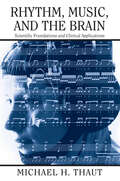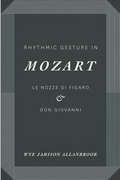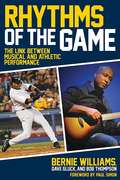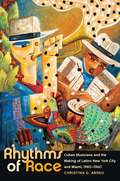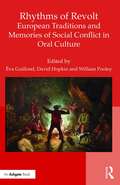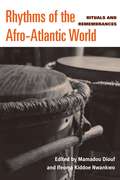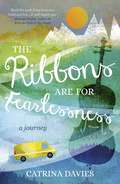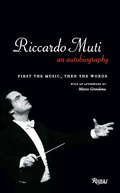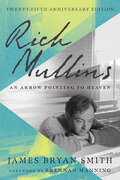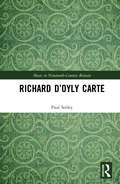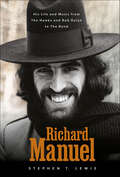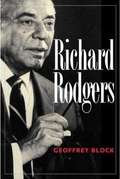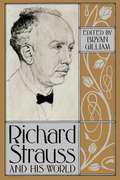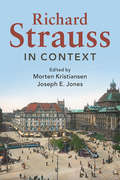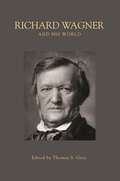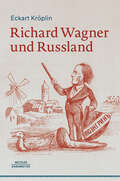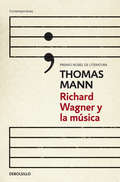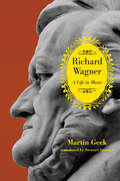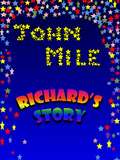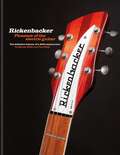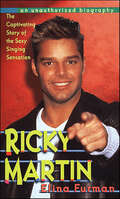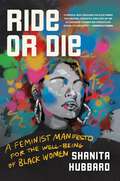- Table View
- List View
Rhythm, Music, and the Brain: Scientific Foundations and Clinical Applications
by Michael ThautWith the advent of modern cognitive neuroscience and new tools of studying the human brain "live," music as a highly complex, temporally ordered and rule-based sensory language quickly became a fascinating topic of study. The question of "how" music moves us, stimulates our thoughts, feelings, and kinesthetic sense, and how it can reach the human experience in profound ways is now measured with the advent of modern cognitive neuroscience. The goal of Rhythm, Music and the Brain is an attempt to bring the knowledge of the arts and the sciences and review our current state of study about the brain and music, specifically rhythm. The author provides a thorough examination of the current state of research, including the biomedical applications of neurological music therapy in sensorimotor speech and cognitive rehabilitation. This book will be of interest for the lay and professional reader in the sciences and arts as well as the professionals in the fields of neuroscientific research, medicine, and rehabilitation.
Rhythmic Gesture in Mozart: Le Nozze di Figaro & Don Giovanni
by Wye Jamison AllanbrookWye Jamison Allanbrook’s widely influential Rhythmic Gesture in Mozart challenges the view that Wolfgang Amadeus Mozart’s music was a “pure play” of key and theme, more abstract than that of his predecessors. Allanbrook’s innovative work shows that Mozart used a vocabulary of symbolic gestures and musical rhythms to reveal the nature of his characters and their interrelations. The dance rhythms and meters that pervade his operas conveyed very specific meanings to the audiences of the day.
Rhythms Of The Game: The Link Between Musical and Athletic Performance
by Bernie Williams Bob Thompson Dave GluckBernie Williams' ability to play major league baseball at a high level was directly influenced by his musical training and his deep understanding of the similarities between musical artistry and athletic performance. Through a series of conversations, narratives, and sidebars, the authors (Bernie Williams, Dave Gluck, and Bob Thompson) discover and reveal the influence of music and its rhythms on the game of baseball. Readers of Rhythms of the Game will gain an insight into the similarities between musical artistry and athletic performance. The book is written for musicians and athletes looking to improve their level of performance on the stage or on the field, as well as for a general audience interested in gaining a deeper understanding of the underlying influence of music on the game of baseball.
Rhythms of Labour: Music at Work in Britain
by Emma Robertson Marek Korczynski Michael PickeringWhether for weavers at the handloom, labourers at the plough, or factory workers on the assembly line, music has often been a key texture in people's working lives. This book is the first to explore the rich history of music at work in Britain and charts the journey from the singing cultures of pre-industrial occupations, to the impact and uses of the factory radio, via the silencing effect of industrialisation. The first part of the book discusses how widespread cultures of singing at work were in pre-industrial manual occupations. The second and third parts of the book show how musical silence reigned with industrialisation, until the carefully controlled introduction of Music While You Work in the 1940s. Continuing the analysis to the present day, Rhythms of Labour explains how workers have clung to and reclaimed popular music on the radio in desperate and creative ways.
Rhythms of Race
by Christina D. AbreuAmong the nearly 90,000 Cubans who settled in New York City and Miami in the 1940s and 1950s were numerous musicians and entertainers, black and white, who did more than fill dance halls with the rhythms of the rumba, mambo, and cha cha cha. In her history of music and race in midcentury America, Christina D. Abreu argues that these musicians, through their work in music festivals, nightclubs, social clubs, and television and film productions, played central roles in the development of Cuban, Afro-Cuban, Latino, and Afro-Latino identities and communities. Abreu draws from previously untapped oral histories, cultural materials, and Spanish-language media to uncover the lives and broader social and cultural significance of these vibrant performers.Keeping in view the wider context of the domestic and international entertainment industries, Abreu underscores how the racially diverse musicians in her study were also migrants and laborers. Her focus on the Cuban presence in New York City and Miami before the Cuban Revolution of 1959 offers a much needed critique of the post-1959 bias in Cuban American studies as well as insights into important connections between Cuban migration and other twentieth-century Latino migrations.
Rhythms of Revolt: European Traditions And Memories Of Social Conflict In Oral Culture
by David Hopkin Éva Guillorel William G. PooleyThe culture of insurgents in early modern Europe was primarily an oral one; memories of social conflicts in the communities affected were passed on through oral forms such as songs and legends. This popular history continued to influence political choices and actions through and after the early modern period. The chapters in this book examine numerous examples from across Europe of how memories of revolt were perpetuated in oral cultures, and they analyse how traditions were used. From the German Peasants’ War of 1525 to the counter-revolutionary guerrillas of the 1790s, oral traditions can offer radically different interpretations of familiar events. This is a ‘history from below’, and a history from song, which challenges existing historiographies of early modern revolts.
Rhythms of the Afro-Atlantic World: Rituals and Remembrances
by Mamadou Diouf Ifeoma Kiddoe Nwanko"Collecting essays by fourteen expert contributors into a trans-oceanic celebration and critique, Mamadou Diouf and Ifeoma Kiddoe Nwankwo show how music, dance, and popular culture turn ways of remembering Africa into African ways of remembering. With a mix of Nuyorican, Cuban, Haitian, Kenyan, Senegalese, Trinidagonian, and Brazilian beats, Rhythms of the Afro-Atlantic World proves that the pleasures of poly-rhythm belong to the realm of the discursive as well as the sonic and the kinesthetic. " ---Joseph Roach, Sterling Professor of Theater, Yale University. "As necessary as it is brilliant, Rhythms of the Afro-Atlantic World dances across, beyond, and within the Black Atlantic Diaspora with the aplomb and skill befitting its editors and contributors. " ---Mark Anthony Neal, author of Soul Babies: Black Popular Culture and the Post-Soul Aesthetic. Along with linked modes of religiosity, music and dance have long occupied a central position in the ways in which Atlantic peoples have enacted, made sense of, and responded to their encounters with each other. This unique collection of essays connects nations from across the Atlantic---Senegal, Kenya, Trinidad, Cuba, Brazil, and the United States, among others---highlighting contemporary popular, folkloric, and religious music and dance. By tracking the continuous reframing, revision, and erasure of aural, oral, and corporeal traces, the contributors to Rhythms of the Afro-Atlantic World collectively argue that music and dance are the living evidence of a constant (re)composition and (re)mixing of local sounds and gestures. Rhythms of the Afro-Atlantic World distinguishes itself as a collection focusing on the circulation of cultural forms across the Atlantic world, tracing the paths trod by a range of music and dance forms within, across, or beyond the variety of locales that constitute the Atlantic world. The editors and contributors do so, however, without assuming that these paths have been either always in line with national, regional, or continental boundaries or always transnational, transgressive, and perfectly hybrid/syncretic. This collection seeks to reorient the discourse on cultural forms moving in the Atlantic world by being attentive to the specifics of the forms---their specific geneses, the specific uses to which they are put by their creators and consumers, and the specific ways in which they travel or churn in place. Mamadou Diouf is Leitner Family Professor of African Studies, Director of the Institute of African Studies, and Professor of History at Columbia University. Ifeoma Kiddoe Nwankwo is Associate Professor of English at Vanderbilt University. Jacket photograph by Elias Irizarry
Ribbons Are for Fearlessness: My Journey from Norway to Portugal beneath the Midnight Sun
by Catrina Davies"Read this book if you have ever loved and lost. . . . It will inspire you. ” --Monique Roffey, author of With the Kisses of His Mouth Fuzzy-haired, neurotic, cello-playing Catrina is devastated when her lover, Jack, leaves her to go surfing on the other side of the world. Trapped in a dead-end job and torn by his departure, Catrina dreams of running away. But how do you run away when you’re flat broke? Luckily, her friend Andrew comes up with a plan: they’ll get an old van, turn it into a camper, and busk their way from Norway to Portugal, via the midnight sun. Andrew is one of her oldest friends and they share many of the same passions and interests, including music. When Andrew is killed in a tragic accident, Catrina decides to go it alone, encountering one disaster after another. She sleeps in her van, gets lost, and struggles to find the confidence to play her cello in front of her growing audience, but meets complete strangers who offer her advice, encouragement, and support along the way. Her experiences on the road gradually teach her the real meaning of love, courage, and above all else, the importance of following her dreams. This is an unforgettable story of a journey like no other--a deeply emotional and inspirational debut by a unique storyteller.
Riccardo Muti: An Autobiography - First the Music, Then the Words
by Riccardo Muti"A vivid portrait of life at the top of a podium heap...[a] fascinating memoir - a must-read for all who would gain insights into what makes a dedicated and complicated man of music tick."--Chicago Tribune. From a small town in the south of Italy to the pinnacle of the classical music world, Riccardo Muti has enthralled audiences across the globe as conductor of the world's most prestigious orchestras and opera houses. Now, after fifty years on the podium, he reflects on an extraordinary career, working with the great artists of his generation. Here, for the first time, he shares the personal anecdotes and revelations of a remarkable life in music.
Rich Mullins: An Arrow Pointing to Heaven
by James Bryan SmithExperience Rich Mullins's Legacy of Joy and Real CompassionBeloved contemporary Christian musician Rich Mullins lived his life with abandon for God, leaving the spotlight to teach music among a Navajo community. An accident cut his life short in 1997, but his songs and ragamuffin spirit continue to teach many.Rich Mullins: An Arrow Pointing to HeavenSee the layers of his story through reflections from friends and family, an afterword by Rich's brother David Mullins, and Smith's own bond with him. And in remembrance, be inspired to enjoy God's world as Rich did.
Richard D’Oyly Carte (Music in Nineteenth-Century Britain)
by Paul SeeleyThe first biography of Richard D’Oyly Carte, this is a critical survey of the career of the impresario whose ambitions went beyond the famous partnership of Gilbert and Sullivan. Errors and misconceptions in current literature are challenged and corrected to give a truer portrayal of one of the most influential music theatre promoters in the nineteenth century.
Richard Manuel: His Life and Music, from the Hawks and Bob Dylan to The Band
by Stephen T. LewisFor the first time, the Band's legendary Richard Manuel&’s compositions and performances are analyzed with expert commentary while shining a light on his contributions to all of his bands—and on the undeniable impact he had on rock music. Richard Manuel was a fearless original. Sweetly soulful as a vocalist and endearingly creative as a songwriter and multi-instrumentalist, he was a vital part of some of rock &’n&’ roll&’s pivotal moments, including Bob Dylan&’s controversial move to electric music, Woodstock 1969, and the legendary Last Waltz. Through thoughtful research and analysis, this book places Manuel&’s troubled yet inspired spirit within a musical and historical context. For the first time, Manuel&’s compositions and performances are critiqued with expert commentary—alongside new interviews with family, friends, and fellow musicians, including Eric Clapton and Van Morrison. The story traces Manuel&’s journey from Stratford, Ontario, to Woodstock, New York, and beyond, beginning with his first band, the Revols, then singing the blues with Robbie Robertson, Levon Helm, Rick Danko, and Garth Hudson in the Hawks, the group that would later become the Band. Manuel&’s influence was profound, his distinctive vocals infusing songs with emotion and depth. His songwriting flourished in classics like &“Tears of Rage,&” cowritten with Dylan, and &“We Can Talk.&” His keyboard work added a lovable funkiness to the Band&’s sound, blending elements of rock, folk, country, and blues into what would become the genesis of Americana. Despite the Band&’s successes, Manuel struggled with personal demons, battling addiction and inner turmoil. Looking beyond his human frailty, this book celebrates Richard Manuel&’s immeasurable contributions to music, ensuring that memories of his voice and artistry endure.
Richard Rodgers
by Geoffrey BlockGeoffrey Block examines the entire range of Rodgers's work, providing rich details about the creation, staging, and critical reception of some of his most popular musicals.
Richard Strauss and His World
by Bryan GilliamStrongly influencing European musical life from the 1880s through the First World War and remaining highly productive into the 1940s, Richard Strauss enjoyed a remarkable career in a constantly changing artistic and political climate. This volume presents six original essays on Strauss's musical works--including tone poems, lieder, and operas--and brings together letters, memoirs, and criticism from various periods of the composer's life. Many of these materials appear in English for the first time. The memoirs range from early biographical sketches to Rudolf Hartmann's moving account of his last visit with Strauss shortly before the composer's death. Critical reviews include recently translated essays by Theodor Adorno, Guido Adler, Paul Bekker, and Julius Korngold.
Richard Strauss in Context (Composers in Context)
by Morten Kristiansen Joseph E. JonesRichard Strauss in Context offers a distinctive approach to the study of a composer in that it places the emphasis on contextualizing topics rather than on biography and artistic output. One might say that it inverts the relationship between composer and context. Rather than studies of Strauss's librettists that discuss the texts themselves and his musical settings, for instance, this book offers essays on the writers themselves: their biographical circumstances, styles, landmark works, and broader positions in literary history. Likewise, Strauss's contributions to the concert hall are positioned within the broader development of the orchestra and trends in programmatic music. In short, readers will benefit from an elaboration of material that is either absent from or treated only briefly in existing publications. Through this supplemental and broader contextual approach, this book serves as a valuable and unique resource for students, scholars, and a general readership.
Richard Wagner and His World (The Bard Music Festival #21)
by Thomas S. GreyRichard Wagner (1813-1883) aimed to be more than just a composer. He set out to redefine opera as a "total work of art" combining the highest aspirations of drama, poetry, the symphony, the visual arts, even religion and philosophy. Equally celebrated and vilified in his own time, Wagner continues to provoke debate today regarding his political legacy as well as his music and aesthetic theories. Wagner and His World examines his works in their intellectual and cultural contexts. Seven original essays investigate such topics as music drama in light of rituals of naming in the composer's works and the politics of genre; the role of leitmotif in Wagner's reception; the urge for extinction in Tristan und Isolde as psychology and symbol; Wagner as his own stage director; his conflicted relationship with pianist-composer Franz Liszt; the anti-French satire Eine Kapitulation in the context of the Franco-Prussian War; and responses of Jewish writers and musicians to Wagner's anti-Semitism. In addition to the editor, the contributors are Karol Berger, Leon Botstein, Lydia Goehr, Kenneth Hamilton, Katherine Syer, and Christian Thorau. This book also includes translations of essays, reviews, and memoirs by champions and detractors of Wagner; glimpses into his domestic sphere in Tribschen and Bayreuth; and all of Wagner's program notes to his own works. Introductions and annotations are provided by the editor and David Breckbill, Mary A. Cicora, James Deaville, Annegret Fauser, Steven Huebner, David Trippett, and Nicholas Vazsonyi.
Richard Wagner und Russland
by Eckart KröplinWagner und Russland? Dieser Fragestellung, die in der deutschsprachigen Wagnerliteratur bislang als peripher angesehen wurde, geht Eckart Kröplin in seiner ausführlichen Kulturgeschichte nach, die auch so manche überraschende, bislang nicht bekannte Tatsachen vorstellt. Er beschreibt wesentliche biografische Momente wie Wagners Kapellmeistertätigkeit in Riga, sein Verhältnis zum russischen Revolutionär Bakunin, seine große Konzertreise 1863 nach Petersburg und Moskau, das Verhältnis russischer Musiker und Dichter zu dem deutschen Komponisten und dessen revolutionären ästhetischen Ideen und weiterhin auch die zeitweilige Dominanz Wagnerscher Opern im Repertoire der Opernhäuser und Konzertsäle des Landes oder seine herausragende Bedeutung für die Künstlerkreise des russischen Symbolismus und schließlich seine widerspruchsvolle Rezeption nach der Oktoberrevolution und unter der Stalinherrschaft. In Wagners Verhältnis zu Russland bzw. Russlands Verhältnis zu Wagner spiegelt sich ein facettenreiches Spannungsfeld europäischer Kulturgeschichte.
Richard Wagner y la música
by Thomas MannLa evolución de una pasión durante toda una vida: el arte de Richard Wagner según Thomas Mann. Thomas Mann reservó su entusiasmo y sabiduría de lector meticuloso para aquellos autores cuyas obras le hicieron soñar. Como figura central de este panteón de padrinos culturales se alza Richard Wagner, pasión fundamental del escritor y piedra de toque de algunas de sus novelas. Este libro ofrece una visión plural y cambiante del compositor, a quien Mann admiró sobre todo por haber sabido trascender las limitaciones específicas de su campo y aspirar a la universalidad. «Realmente, no es difícil advertir un hálito del espíritu que anima El anillo de los Nibelungos en mis Buddenbrook, en esa procesión épica de generaciones unidas y entrelazadas gracias a un conjunto de motivos centrales.»Thomas Mann
Richard Wagner: A Life in Music
by Martin Geck“[An] intriguing exploration of the composer’s life and thought as exemplified by his music. An excellent biography.” —Library JournalBest known for the four-opera cycle The Ring of the Nibelung, Richard Wagner (1813–83) was a conductor, librettist, theater director, and essayist, in addition to being the composer of some of the most enduring operatic works in history. Though his influence on the development of European music is indisputable, Wagner was also quite outspoken on the politics and culture of his time. His ideas traveled beyond musical circles into philosophy, literature, theater staging, and the visual arts. To befit such a dynamic figure, acclaimed biographer Martin Geck offers here a Wagner biography unlike any other, one that strikes a unique balance between the technical musical aspects of Wagner’s compositions and his overarching understanding of aesthetics. A landmark study of one of music’s most important figures“People who would like to know more about Wagner, and people who have loved his music for years . . . will find a great deal in this book to enjoy and to admire.” —Tablet“Geck describes a Wagner who is grounded, focused and even cautious, a savvy realist and ironist rather than a flamboyant, flailing ideologue . . . Suffused with his readings of contemporary productions of the operas, Geck’s musical analyses are succinct and superb” —New York Times“As an editor of Wagner’s Complete Works, Geck brings a deep familiarity with the composer to his task.” —Weekly Standard“A thoroughly approachable yet consistently provocative study.” —Thomas S. Grey, editor of The Cambridge Companion to Wagner
Richard Wagner: A Research and Information Guide (Routledge Music Bibliographies)
by Michael SaffleRichard Wagner: A Research and Information Guide is an annotated bibliography concerning both the nature of primary sources related to the composer and the scope and significance of the secondary sources which deal with him, his compositions, and his influence as a composer and performer.
Richard's story
by Fernanda Silva Rando John MileRichard's story é um musical para ler inspirado nas canções dos Beatles e conta, numa sucessão de experiências e emoções, a vida do jovem Richard. De “Twist and shout” e ”Please, please me”, passando por “All my loving”, “A hard day’s night”, “I want hold your hand”, chegando a “Help!”, “Yesterday”, “Drive my car”, a história de Richard se desenvolve com “Day tripper”, “Love you to”, “A day in the life”. A viagem continua com “Magical Mistery tour”, “Hello, goodbye” e “Lucy in the sky with diamond”. Momentos felizes descritos por “Obladì, obladà” se alternam com momentos tristes, “Happiness is a warm gun”; o amor fascinante com “Julia” e perturbador com “Oh! Darling” se contrapõe ao desespero em “I’m so tired”; o desejo juvenil de revolta em “Revolution”, contrapõe-se à consciência do amadurecimento e à nostalgia dos tempos passados com “Penny Lane”. Todas as canções dos Beatles são fontes de inspiração para contar, por meio de Richard, as primeiras experiências com as garotas, as primeiras desilusões, a amizade, os primeiros problemas com os pais, a descoberta da alegria, a experiência com a droga, o medo de ficar sozinho, a busca por ajuda e, naturalmente, a descoberta do amor, em todas as suas formas e nuances. Imaginem ser levados em um vórtice de felicidade, dançando o twist. Imaginem ser arrebatados pela paixão do primeiro amor. Imaginem fugir de casa e descobrir lugares novos e conhecer amigos novos. Imaginem fazer uma fantástica viagem com o Magical Mistery Tour em pleno anos 60.
Rickenbacker Guitars: The definitive history of a 20th-century icon
by Martin Kelly Paul KellyA STUNNING NEW AND COMPLETELY REVISED EDITION OF THE RICKENBACKER BIBLE FOR 2023'Knowing Martin and Paul Kelly's perfectionism and attention to detail it's no surprise that this is the ultimate and complete story of all things Rickenbacker.' - Johnny Marr'A wonderful history of my favourite guitar. The attention to detail is amazing!' - Roger McGuinn'There are few things more satisfying than the shimmer of an open chord played on a Rickenbacker through a Fender Deluxe Reverb amplifier. Martin and Paul have given us the definitive history of these magical instruments.' - Susanna HoffsRickenbacker Guitars is the highly anticipated follow up to Fender: The Golden Age, charting the story of one of the most important and influential guitar makers of all time. From George Beauchamp's invention of the world's first commercially viable electric guitar in 1931, through the company's heyday during the 1960s - when their instruments were favoured by The Beatles, The Byrds and The Who - and up to the continuing legacy of Rickenbacker today.This definitive collection features unprecedented access to the company archives, 350 beautifully photographed original instruments - including all 7 surviving Beatles owned Rickenbackers - and new interviews with legendary Rickenbacker players such as Roger McGuinn, Peter Buck, Susanna Hoffs, Johnny Marr, Mike Campbell, Geddy Lee and Paul Weller.Rickenbacker Guitars is the most comprehensive history of the brand to date and a must-have for all guitar enthusiasts.
Rickenbacker Guitars: The definitive history of a 20th-century icon
by Martin Kelly Paul KellyA STUNNING NEW AND COMPLETELY REVISED EDITION OF THE RICKENBACKER BIBLE FOR 2023'Knowing Martin and Paul Kelly's perfectionism and attention to detail it's no surprise that this is the ultimate and complete story of all things Rickenbacker.' - Johnny Marr'A wonderful history of my favourite guitar. The attention to detail is amazing!' - Roger McGuinn'There are few things more satisfying than the shimmer of an open chord played on a Rickenbacker through a Fender Deluxe Reverb amplifier. Martin and Paul have given us the definitive history of these magical instruments.' - Susanna HoffsRickenbacker Guitars is the highly anticipated follow up to Fender: The Golden Age, charting the story of one of the most important and influential guitar makers of all time. From George Beauchamp's invention of the world's first commercially viable electric guitar in 1931, through the company's heyday during the 1960s - when their instruments were favoured by The Beatles, The Byrds and The Who - and up to the continuing legacy of Rickenbacker today.This definitive collection features unprecedented access to the company archives, 350 beautifully photographed original instruments - including all 7 surviving Beatles owned Rickenbackers - and new interviews with legendary Rickenbacker players such as Roger McGuinn, Peter Buck, Susanna Hoffs, Johnny Marr, Mike Campbell, Geddy Lee and Paul Weller.Rickenbacker Guitars is the most comprehensive history of the brand to date and a must-have for all guitar enthusiasts.
Ricky Martin: An Unauthorized Biography
by Elina FurmanSmart, sexy, and soulful, Ricky Martin is more than a pop star. He's an accomplished actor and Grammy-award-winning singer who takes himself and his music seriously. Immensely talented, he started out young, acting in commercials at the age of six, and eventually joined the hugely successful singing group Menudo. In 1994 he joined the cast of the highly rated soap opera General Hospital and later landed the lead role in the smash Broadway musical Les Miserables, two career moves which would launch him into world-wide superstardom. From there, Ricky wanted to return to his first love, singing--and he did it with a bang, creating two multi-platinum solo albums, which won him a Grammy for Best Latin Pop Performance.What's next for this gifted heartthrob? With show-stopping good looks, talent to spare, and ambition to burn, the sky seems to be the limit. Find out about the man behind the image...discover what this cute crooner has said about his success, love, and music...learn about the real Ricky Martin--you'll be glad you did!
Ride or Die: A Feminist Manifesto for the Well-Being of Black Women
by Shanita HubbardCultural criticism and pop culture history intertwine in this important book, which dissects how hip hop has sidelined Black women's identity and emotional well-being. A &“ride-or-die chick&” is a woman who holds down her family and community. She&’s your girl that you can call up in the middle of the night to bail you out of jail, and you know she&’ll show up and won&’t ask any questions. Her ride-or-die trope becomes a problem when she does it indiscriminately. She does anything for her family, friends, and significant other, even at the cost of her own well-being. &“No&” is not in her vocabulary. Her self-worth is connected to how much labor she can provide for others. She goes above and beyond for everyone in every aspect of her life—work, family, church, even if it&’s not reciprocated, and doesn&’t require it to be because she&’s a &“strong Black woman&” and everyone&’s favorite ride-or-die chick. To her, love should be earned, and there&’s no limit to what she&’ll do for it. In this book, author, adjunct professor of sociology, and former therapist Shanita Hubbard disrupts the ride-or-die complex and argues that this way of life has left Black women exhausted, overworked, overlooked, and feeling depleted. She suggests that Black women are susceptible to this mentality because it&’s normalized in our culture. It rings loud in your favorite hip-hop songs, and it even shows up in the most important relationship you will ever have—the one with yourself. Compassionate, candid, hard-hitting, and 100 percent unapologetic, Ride or Die melds Hubbard&’s entertaining conversations with her Black girlfriends and her personal experiences as a redeemed ride-or-die chick and a former &“captain of the build-a-brother team&” to fervently dismantle cultural norms that require Black women to take care of everyone but themselves. Ride or Die urges you to expel the myth that your self-worth is connected to how much labor you provide others and guides you toward healing. Using hip hop as a backdrop to explore norms that are harmful to Black women, Hubbard shows the ways you may be unknowingly perpetuating this harm within your relationships. This book is an urgent call for you to pull the plug on the ride-or-die chick.
